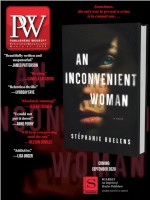In 1971, crime writer Ann Rule befriended a fellow volunteer at a suicide crisis hotline center in Seattle. The seemingly well-mannered young man was Ted Bundy, later a notorious serial killer and the subject of Rule’s seminal work, The Stranger Beside Me. Rule, who died in 2015, went on to have a prolific career in true crime, and now her daughter Leslie Rule, a novelist, is following in her mother’s footsteps. In Leslie Rule’s true crime debut, A Tangled Web (Citadel, Apr.), she traces the story of Shanna Golyar, convicted of killing a woman named Cari Farver and for years after impersonating her via phone and email.
What led you to Shanna Golyar’s story?
I looked for a case with a female who killed because I want to remind readers that women can be dangerous. Most of the crime stories published today focus on male killers, and it’s easy to forget that the so-called gentler sex can be vicious and deadly. The cases that make the best books are the ones that are difficult for detectives to solve, and that’s another reason I chose the Golyar case. Cari Farver disappeared in 2012, but her family didn’t get justice until 2017. Detectives had to work overtime to gather enough evidence to see the killer convicted. I also wanted a story with a twist, and this one has a modern edge—the killer used electronics to both commit and conceal her crimes.
What was it like growing up with a mom who wrote true crime?
When I was a rebellious teen, I thought my mom was paranoid because she worried about me so much. In the 1970s, she wrote two articles each week for true crime magazines, and many of the victims in the stories were girls my age. As I was leafing through those old magazines recently, I was struck by the realization that my mother had to have had a great deal of self-control to allow me as much freedom as she did. The victims’ fates were horrific, and some of the attacks occurred just blocks from our home. At age 15, I believed I was invincible and was annoyed by the lectures. I now realize my mother was not as paranoid as I once believed.
You worked with your mother on some of her books. How’d that go?
I was 17 when my mother started taking me to trials. It was my job to photograph the killers. Some of my subjects whipped out combs, fixed their hair, and posed, while others glared. That was fine with me. A photo of a scowling killer was a nice addition to my mother’s articles.
How did your mom influence your reporting and writing of A Tangled Web?
My mother was very sensitive to the victims. Before I even mentioned the Golyar case to my editor, I talked to Nancy Raney, mother of Cari Farver. I told Nancy I would write the story only if she felt it would be healing for her. Once Nancy gave me the okay, I wrote the book proposal. I checked with Nancy every step of the way as I wrote the book. I also followed my mother’s example when it came to the detectives and the other people involved in the case. I learned a lot of confidential information that would have made for a juicier book, but revealing it would have hurt people. I kept the secrets told to me.



 Volume 267
Issue 12
03/23/2020
Volume 267
Issue 12
03/23/2020





